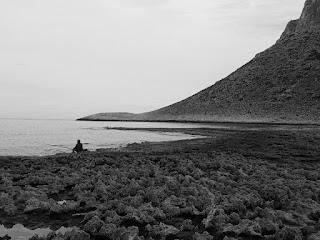Local Delicacy
He said that there were no more intestines. I was disappointed. I’d never felt this way about internal organs before, at least not about those that didn’t belong to me. Having searched through a bunch of local tavernas in and around town, I had finally found a restaurant serving the alleged local specialty of gardoumakia. The dish, so I was told, was lamb belly, or some other type of offal, wrapped in intestines and then cooked in an undisclosed sauce. Some might squirm at the description of such a food, but I wasn’t willing to make up my mind until I had tried it. Although I did have some doubts. I wondered how delicious it really was given that it was apparently a Cretian delicacy and yet in four days on the island I was unable to find anyone willing to serve it. At least that was until I arrived in a local restaurant just outside Chania’s old city.
The restaurant chef/owner was a tall balding Greek man with a navy blue chefs’ jacket covered in tomato stains (I hope). His arms were covered in the hair that should have been on his head. He stood proudly, using a large metal spoon to punctuate each phrase as he listed the array of dishes sitting in the bain-marie in front of him. “I have lamb. I have eggplant. I have stuffed vegetable. I have...” “Yes, but do you have gardoumakia?” I interjected. He explained that they had them earlier during the day, at lunchtime, but now that it was dinnertime there weren’t any left. It seemed that intestines were something you only had in the daytime, like a mimosa. Everyone talks about Dracula only sucking blood after sunset but they always leave out the bit about him saving the internal organs as a kind-of midday snack. “We have again on Friday, maybe Thursday,” the restauranteur assured me. But I was leaving on Wednesday.
Overcome with offal outrage, I settled in from some pastistio instead. The long, tubular pasta shapes that filled the layered dish acted as a solemn reminder of the intestines that would never reach my own.
If Heraklion had left a little to be desired from the Cretian experience, Chania had provided me with what I needed. In my few days in Heraklion I had experienced weather that was overcast, drizzly, windy and cold. At times I questioned if this really was a beach resort town. Sure, it was the offseason, but I found it hard to believe that even in the summer it would be nice enough to swim. But as the bus pulled out of the station at Heraklion the sun shot through the clouds and the day began to warm up.
The drive to Chania followed the coastal road along the northern edge of Crete. With rocky mountains that shot out close to the water’s edge, the road straddled the sheer mountainside with the winding coast. The morning sun shone over the mountain range, illuminating the orange soil and flecks of white rock beneath. Clusters of yellow flowers studded the verdant countryside, blanketed by natural shrubs and groves of cultivated grey olive trees. Behind, in the not-too-far distance, larger mountains arose, with snow that dusted their peaks like cocaine at the end of a user’s nostrils.
Goats bleated as they scavenged their way through the green bushes over the hills. (These goats do add to the romantic image but, as I found out climbing up to the mountainside the following day, the mountain is covered in their excrement which after a while becomes hard to avoid and ends up ruining an otherwise perfectly good pair of shoes.) Large clumps of dark green and pink pigface bushes clawed their way out of the ground, a reminder that, though seemingly mountainous on one side, we were still very much on the coast.
I soon arrived in Chania, captivated by the yellow terraces squashed together to make the old city. Pastel coloured buildings lined the small harbour and, in the morning sun, provided a glimmering reflection on the placid water like a watercolour painting.

















